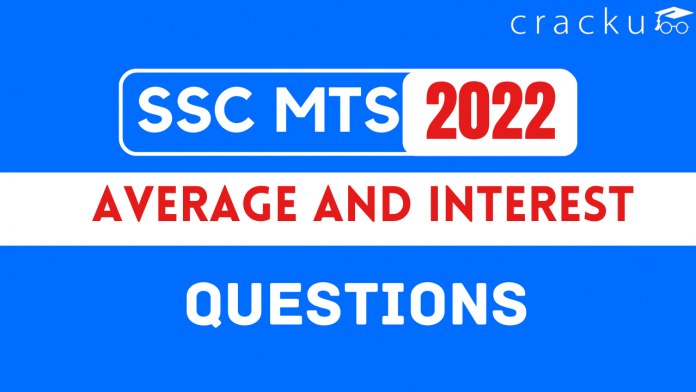Average and Interest Questions for SSC MTS
Here you can download the Average and Interest Questions for SSC MTS PDF with solutions by Cracku. These are the most important Average and Interest questions PDF prepared by various sources also based on previous year’s papers. Utilize this PDF for Average and Interest for SSC MTS preparation. You can find a list of the most important Average and Interest questions in this PDF which help you to test yourself and practice. So you can click on the below link to download the PDF for reference and do more practice.
Download Average and Interest Questions for SSC MTS
Enroll to 15 SSC MTS 2022 Mocks At Just Rs. 149
Question 1: A fruit seller has a sale of ₹10,435, ₹9,927,₹10,855 ₹10,230 and ₹9,562 for five consecutive months.How much sale (in ₹) must he have in the sixth month so that he gets an average sale of ₹10,500?
a) 9,231
b) 8,231
c) 8,991
d) 11,991
1) Answer (D)
Solution:
As we know,
Average = $\frac{Sumofobservation}{total\ number\ of\ observation}$
Let the sale of 6th month be x
Average = $\frac{\left(10435+9927+10855+10230+9562+x\right)}{6}=10500$
= $51009\ +\ x=63000$
x = 11991
Hence, option D is correct.
Question 2: The average weight of 6 people increased by 2.5 kg when a new person came in place of other person weighing 55 kg. what can be the weight of new person (in kg)?
a) 70
b) 62.5
c) 60
d) 75.5
2) Answer (A)
Solution:
Total weight increased = number of persons $\times\ $ increased weight
i.e;$6\times\ 2.5=15$
Weight of new person = weight of replaced person + Total increased weight
i.e; 55 + 15 = 70 kg
Hence, Option A is correct.
Question 3: The average of eleven numbers is 56. The average of first three numbers is 52 and that of next five numbers is 60. The 9th and 10th number are 3 and 1 more than the 11th number respectively. What is the average of 9th and 11th numbers?
a) 53.5
b) 52
c) 52.5
d) 54
3) Answer (A)
Solution:
The average of first three numbers is 52.
Sum of the first three numbers = 52 x 3 = 156
The average of next five numbers is 60.
Sum of the next five numbers = 60 x 5 = 300
Let the 11th number be ‘n’.
The average of eleven numbers is 56.
Sum of the eleven numbers = 56 x 11 = 616
156 + 300 + (n + 3) + (n + 1) + n = 616
3n + 460 = 616
3n = 156
n = 52
Average of 9th and 11th numbers = $\frac{(n+3)+n}{2}$
= $\frac{107}{2}$
= 53.5
Hence, the correct answer is Option A
Question 4: The average of 23 numbers is 51. The average of first 12 numbers is 49 and the average of last 12 numbers is 54. If the twelfth number is removed, then the average of the remaining numbers (correct to two decimal places) is:
a) 53:25
b) 50.45
c) 51.75
d) 52.65
4) Answer (B)
Solution:
The average of 23 numbers is 51.
Sum of the 23 numbers = 51 x 23 = 1173…….(1)
The average of first 12 numbers is 49.
Sum of the first 12 numbers = 49 x 12 = 588
Sum of the first 11 numbers + 12th number = 588…..(2)
The average of last 12 numbers is 54.
Sum of the last 12 numbers = 54 x 12 = 648
12th number + Sum of the last 11 numbers = 648…..(3)
Adding (2) and (3),
Sum of the first 11 numbers + 12th number + 12th number + Sum of the last 11 numbers = 588 + 648
(Sum of the first 11 numbers + 12th number + Sum of the last 11 numbers) + 12th number = 1236
Sum of the 23 numbers + 12th number = 1236
1173 + 12th number = 1236
12th number = 63
Required average = $\frac{1173-63}{22}$
= 50.4545
Hence, the correct answer is Option B
Question 5: The average weight of a certain number of students in a class is 55.5 kg. If 4 students with average weight 60 kg join the class, then the average weight of all students in the class increases by 360 g. The number of students in the class, initially, is:
a) 46
b) 31
c) 41
d) 36
5) Answer (A)
Solution:
Let the initial number of students = n
Average of the weight of ‘n’ students = 55.55
Sum of the weight of ‘n’ students = 55.55n
Sum of the weight of 4 students = 60 x 4 = 240 kg
According to the problem,
$\frac{55.55n+240}{n+4}=55.55+\frac{360}{1000}$
$\frac{55.55n+240}{n+4}=55.55+0.36$
$\frac{55.55n+240}{n+4}=55.86$
55.55n + 240 = 55.86n + 223.44
0.36n = 16.56
n = 46
The initial number of students = n = 46
Hence, the correct answer is Option A
Take a free SSC MTS Tier-1 mock test
Download SSC CGL Tier-1 Previous Papers PDF
Question 6: The average monthly salary of 60 employees of a factory is ₹29900. If two officers are getting ₹90000 each and the average salary of 8 supervisors is ₹65000, then what is the average salary (in ₹) of the remaining employees?
a) 22680
b) 29080
c) 21080
d) 21880
6) Answer (D)
Solution:
The average monthly salary of 60 employees of the factory is ₹29900.
Total monthly salary of 60 employees of the factory = 29900 x 60 = ₹1794000
Two officers are getting ₹90000 each.
Sum of the salary of two officers = 2 x 90000 = ₹180000
The average salary of 8 supervisors is ₹65000.
Total salary of 8 supervisors = 65000 x 8 = ₹520000
Total salary of remaining 50 employees of the factory = 1794000 – 180000 – 520000 = ₹1094000
Average of remaining 50 employees of the factory = $\frac{1094000}{50}$ = ₹21880
Hence, the correct answer is Option D
Question 7: The average daily production of toys in a factory in the month of December is 512. If the average production during first 20 days is 515 and that of the last 13 days is 510, then what is the average of production on 19 and 20 December?
a) 1058
b) 513
c) 529
d) 512
7) Answer (C)
Solution:
The average daily production of toys in a factory in the month of December is 512.
Total production of toys in the month of December = 512 x 31 = 15872……..(1)
The average production during first 20 days is 515.
Total production during first 20 days = 515 x 20 = 10300
Production during first 18 days + 19 December + 20 December = 10300……..(2)
The average production during last 13 days is 510.
Total production during last 13 days = 510 x 13 = 6630
19 December + 20 December + Production during last 11 days = 6630……..(3)
Solving (2) + (3) – (1), we get
19 December + 20 December = 10300 + 6630 – 15872
19 December + 20 December = 1058
Total production on 19 and 20 December = 1058
Average of production on 19 and 20 December = $\frac{1058}{2}$ = 529
Hence, the correct answer is Option C
Question 8: The average of 40 numbers is 36. The average of the first 25 numbers is 31 and the average of last 16 numbers is 43. Find the 25th number.
a) 21
b) 23
c) 24
d) 22
8) Answer (B)
Solution:
Given, average of 40 numbers = 36
$\Rightarrow$ Sum of 40 numbers = 36 x 40 = 1440………………(1)
The average of the first 25 numbers is 31
$\Rightarrow$ Sum of first 25 numbers = 31 x 25 = 775
$\Rightarrow$ Sum of first 24 numbers + 25th number = 775 ……(2)
The average of last 16 numbers is 43
$\Rightarrow$ Sum of last 16 numbers = 43 x 16 = 688 ………….(3)
Adding equations (2) and (3),
Sum of first 24 numbers + 25th number + Sum of last 16 numbers = 775 + 688
$\Rightarrow$ Sum of first 24 numbers + Sum of last 16 numbers + 25th number = 1463
$\Rightarrow$ Sum of 40 numbers + 25th number = 1463
$\Rightarrow$ 1440 + 25th number = 1463
$\Rightarrow$ 25th number = 23
Hence, the correct answer is Option B
Question 9: The average of 24 numbers is 26. The average of the first 15 numbers is 23 and that of the last 8 number is 33. Find the 16$^{th}$ number.
a) 16
b) 17
c) 15
d) 18
9) Answer (C)
Solution:
Given, the average of the first 15 numbers is 23
$\Rightarrow$ Sum of first 15 numbers = 23 x 15 = 345
Average of last 8 numbers is 33
$\Rightarrow$ Sum of last 8 numbers = 33 x 8 = 264
Average of 24 numbers is 26
$\Rightarrow$ Sum of 24 numbers = 26 x 24 = 624
$\Rightarrow$ Sum of first 15 numbers + 16th number + Sum of last 8 numbers = 624
$\Rightarrow$ 345 + 16th number + 264 = 624
$\Rightarrow$ 16th number = 15
Hence, the correct answer is Option C
Question 10: The average of four consecutive odd natural numbers is eight less than the average of three consecutive even natural numbers. If the sum of these three even numbers is equal to the sum of above four odd numbers, then the average of four original odd numbers is:
a) 32
b) 24
c) 18
d) 36
10) Answer (B)
Solution:
Let the four consecutive odd natural numbers are a, a+2, a+4, a+6
Let the three consecutive even natural numbers are b, b+2, b+6
Average of four consecutive odd natural numbers = $\frac{a+a+2+a+4+a+6}{4}=\frac{4a+12}{4}=a+3$
Average of three consecutive even natural numbers = $\frac{b+b+2+b+4}{3}=\frac{3b+6}{3}=b+2$
The average of four consecutive odd natural numbers is eight less than the average of three consecutive even natural numbers.
$\Rightarrow$ $a+3=b+2-8$
$\Rightarrow$ $b-a=9$ ………(1)
The sum of the three even numbers is equal to the sum of four odd numbers.
$\Rightarrow$ $b+b+2+b+4=a+a+2+a+4+a+6$
$\Rightarrow$ $3b=4a+6$
$\Rightarrow$ $3b-4a=6$ ……(2)
Solving 3(1)-(2) we get, $a = 21$
$\therefore\ $Average of four consecutive odd natural numbers = $a+3=21+3=24$
Hence, the correct answer is Option B
Question 11: What is the difference (in ₹) between the compound interest, when interest is compounded 6-monthly, and the simple interest on a sum of ₹10,000 for $1\frac{1}{2}$ years at 10% p.a.?
a) 102.25
b) 87
c) 76.25
d) 91.5
11) Answer (C)
Solution:
If interest is half-yearly, Then
Time = $1.5\times\ 2=3$
Rate = $\frac{10}{2}=\ 5\%$
$A=P\left(1+\frac{r}{100}\right)^n$
= $A=10,000\left(1+\frac{5}{100}\right)^3$
$A=10,000\ \times\ \frac{21}{20}\times\ \frac{21}{20}\times\ \frac{21}{20}=11576.25$
C.I = A – P = 11576.25 – 10000 = ₹1576.35
Simple Interest = $S.I\ =\frac{\left(P\times\ R\times\ T\right)}{100}$
= $\frac{\left(10000\times\ 10\times\ 1.5\right)}{100}$
= ₹1500
Required Difference = ₹1576.25 – ₹1500 = ₹76.25
Hence, Option C is correct.
Question 12: A sum of ₹25600 is invested on simple interest partly at 7% per annum and the remaining at 9% per annum. The total interest at the end of 3 years is ₹5832. How much money(in ₹) was invested at 9% per annum?
a) 18000
b) 7600
c) 9600
d) 16000
12) Answer (B)
Solution:
Let the amount invested in 9% per annum = P
Amount invested in 7% per annum = 25600 – P
The total interest at the end of 3 years is ₹5832.
P x 3 x $\frac{9}{100}$ + (25600 – P) x 3 x $\frac{7}{100}$ = 5832
$\frac{9}{100}$P + 1792 – $\frac{7}{100}$P = 1944
$\frac{2}{100}$P = 152
P = ₹7600
$\therefore$ Amount invested at 9% per annum = P = ₹7600
Hence, the correct answer is Option B
Question 13: Two equal sums were lent on simple interest at 6% and 10% per annum respectively. The first sum was recovered two years later than the second sum and the amount in each case was ₹1105. What was the sum (in ₹) lent in each scheme?
a) 900
b) 850
c) 936
d) 891
13) Answer (B)
Solution:
Let the sum lent in each scheme = P
Let the sum at 6% and 10% simple interest was recovered after ‘t+2’ years and ‘t’ years respectively.
Amount obtained from simple interest at 6% = P + $\frac{P\times(t+2)\times6}{100}$
1105 = P + $\frac{P\times(t+2)\times6}{100}$
1105 – P = $\frac{P\times(t+2)\times6}{100}$…….(1)
Amount obtained from simple interest at 10% = P + $\frac{P\times t\times10}{100}$
1105 = P + $\frac{P\times t\times10}{100}$
1105 – P = $\frac{P\times t\times10}{100}$……..(2)
From (1) and (2),
$\frac{P\times(t+2)\times6}{100}$ = $\frac{P\times t\times10}{100}$
6t + 12 = 10t
t = 3
Substituting t = 3 in equation (2), we get P = 850
The sum lent in each scheme = ₹850
Hence, the correct answer is Option B
Question 14: A sum of ₹9500 amounts to ₹11495 in 2 years at a certain rate percent per annum, interest compounded yearly. What is the simple interest (in ₹) on the same sum for the same time and double the rate?
a) 3990
b) 3420
c) 4560
d) 3800
14) Answer (D)
Solution:
Let the rate of interest = R
11495 = 9500(1+$\frac{R}{100}$)$^2$
(1+$\frac{R}{100}$)$^2$ = $\frac{11495}{9500}$
(1+$\frac{R}{100}$)$^2$ = $\frac{121}{100}$
1+$\frac{R}{100}$ = $\frac{11}{10}$
$\frac{R}{100}$ = $\frac{1}{10}$
R = 10%
Simple interest = $\frac{9500\times2\times20}{100}$
= ₹3800
Hence, the correct answer is Option D
Question 15: A person borrowed a sum of ₹30800 at 10% p.a. for 3 years, interest compounded annually. At the end of two years, he paid a sum of ₹13268. At the end of 3rd year, he paid ₹ x to clear of the debt. What is the value of x ?
a) 26400
b) 26510
c) 26200
d) 26620
15) Answer (A)
Solution:
Amount to be paid after 2 years = 30800(1+$\frac{10}{100}$)$^2$
= 30800($\frac{11}{10}$)$^2$
= 30800($\frac{121}{100}$)
= ₹37268
Amount paid by the person = ₹13268
Remaining amount = ₹37268 – ₹13268 = ₹24000
Amount to be paid at the end of 3rd year to clear debt(i.e, compound interest on ₹24000 for next 1 year) = 24000(1+$\frac{10}{100}$)$^1$
$\Rightarrow$ x = 24000($\frac{11}{10}$)
$\Rightarrow$ x = ₹26400
Hence, the correct answer is Option A
Question 16: At what rate percent per annum will ₹7200 amountto ₹7938 in one year, if interest is compounded half yearly?
a) 5
b) 8
c) 12
d) 10
16) Answer (D)
Solution:
Let the rate of interest per annum = R
According to the problem,
7938 = 7200(1+$\frac{\frac{R}{2}}{100}$)$^2$
3969 = 3600(1+$\frac{\frac{R}{2}}{100}$)$^2$
441 = 400(1+$\frac{\frac{R}{2}}{100}$)$^2$
(1+$\frac{\frac{R}{2}}{100}$)$^2$ = $\frac{441}{400}$
1+$\frac{\frac{R}{2}}{100}$ = $\frac{21}{20}$
$\frac{R}{200}$ = $\frac{1}{20}$
R = 10%
Hence, the correct answer is Option D
Question 17: A sum at simple interest becomes two times in 8 years at a certain rate of interest p.a. The time in which the same sum will be 4 times at the same rate of interest at simple interest is:
a) 25 years
b) 20 years
c) 30 years
d) 24 years
17) Answer (D)
Solution:
Let the principal amount = P
Rate of interest = R
Time = 8 years
Amount = 2P
$\Rightarrow$ 2P = Principal amount + Simple Interest
$\Rightarrow$ 2P = P + $\frac{\text{P}\times8\times \text{R}}{100}$
$\Rightarrow$ P = $\frac{\text{P}\times8\times \text{R}}{100}$
$\Rightarrow$ R = 12.5%
Let the time in which sum will be 4 times at the same rate of interest = T
i.e, Amount = 4P
$\Rightarrow$ 4P = P + $\frac{\text{P}\times \text{T}\times12.5}{100}$
$\Rightarrow$ 3P = $\frac{\text{P}\times \text{T}\times12.5}{100}$
$\Rightarrow$ 3 = $\frac{\text{T}}{8}$
$\Rightarrow$ T = 24 years
$\therefore\ $The time in which the same sum will be 4 times at the same rate of interest = 24 years
Hence, the correct answer is Option D
Question 18: Suresh lent out a sum of money to Rakesh for 5 years at simple interest. At the end of 5 years, Rakesh paid 9/8 of the sum to Suresh to clear out the amount. Find the rate of simple interest per annum.
a) 3.5% p.a.
b) 2.5% p.a.
c) 3% p.a.
d) 2% p.a.
18) Answer (B)
Solution:
Let the sum of money lent out by Suresh to Rakesh = P
Amount paid by Rakesh to Suresh after 5 years = $\frac{9}{8}$P
Let the rate of simple interest = R%
$\Rightarrow$ P + $\frac{\text{P}\times5\times \text{R}}{100}$ = $\frac{9}{8}$P
$\Rightarrow$ 1 + $\frac{R}{20}$ = $\frac{9}{8}$
$\Rightarrow$ $\frac{R}{20}$ = $\frac{9}{8}-1$
$\Rightarrow$ $\frac{R}{20}$ = $\frac{1}{8}$
$\Rightarrow$ R = 2.5%
$\therefore\ $Rate of simple interest per annum = 2.5%
Hence, the correct answer is Option B
Question 19: If the difference between the compound interest and simple interest on a certain sum of money for three years at 10% p.a. is ₹ 558, then the sum is:
a) ₹ 18,500
b) ₹ 15,000
c) ₹ 16,000
d) ₹ 18,000
19) Answer (D)
Solution:
Let the principal sum = P
Rate = 10%
Time = 3 years
Compound interest on the sum = P$\left(1+\frac{10}{100}\right)^3-$ P = P$\left(\frac{110}{100}\right)^3-$ P = P$\frac{1331}{1000}-$ P = $\frac{331}{1000}$P
Simple interest on the sum = $\frac{P\times3\times10}{100}$ = $\frac{3}{10}$P
According to the problem,
$\frac{331}{1000}$P $-$ $\frac{3}{10}$P = 558
$\Rightarrow$ $\frac{331P-300P}{1000}$ = 558
$\Rightarrow$ $\frac{31P}{1000}$ = 558
$\Rightarrow$ P = 18000
$\therefore\ $The principal sum = ₹ 18,000
Hence, the correct answer is Option D
Question 20: The sum of simple interest on a sum at 8% p.a. for 4 years and 8 years is ₹960. The sum is:
a) ₹800
b) ₹1100
c) ₹1000
d) ₹900
20) Answer (C)
Solution:
Let the Principal amount = P
Rate = 8%
Given, the sum of simple interest on P for 4 years and 8 years is ₹960
$\Rightarrow$ $\frac{P\times4\times8}{100}+\frac{P\times8\times8}{100}=960$
$\Rightarrow$ $\frac{32P}{100}+\frac{64P}{100}=960$
$\Rightarrow$ $\frac{96P}{100}=960$
$\Rightarrow$ P = 1000
$\therefore\ $The required sum = ₹1000
Hence, the correct answer is Option C





